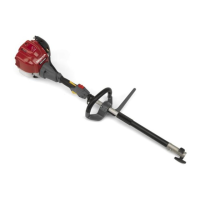23
Carburetor Modifications for High Altitude Operation
At high altitude, the standard carburetor air-fuel mixture will be too rich.
Performance will decrease, and fuel consumption will increase. A very
rich mixture will also foul the spark plug and cause hard starting.
Operation at an altitude that differs from that at which this engine was
certified, for extended periods of time, may increase emissions.
High altitude performance can be improved by specific modifications to
the carburetor. If you always operate your powerhead at altitudes above
2,000 feet (610 meters), have your servicing dealer perform this
carburetor modification. This engine, when operated at high altitude
with the carburetor modifications for high altitude use, will meet each
emission standard throughout its useful life.
Even with carburetor modification, engine horsepower will decrease
about 3.5% for each 1,000-foot (300-meter) increase in altitude. The
effect of altitude on horsepower will be greater than this if no carburetor
modification is made.
When the carburetor has been modified for high altitude operation, the air-
fuel mixture will be too lean for low altitude use. Operation at altitudes below
2,000 feet (610 meters) with a modified carburetor may cause the engine to
overheat and result in serious engine damage. For use at low altitudes, have
your servicing dealer return the carburetor to original factory specifications.
Emission Control System Information
Source of Emissions
The combustion process produces carbon monoxide, oxides of nitrogen,
and hydrocarbons. Control of hydrocarbons and oxides of nitrogen is
very important because, under certain conditions, they react to form
photochemical smog when subjected to sunlight. Carbon monoxide
does not react in the same way, but it is toxic.
Honda utilizes appropriate air/fuel ratios and other emissions control
systems to reduce the emissions of carbon monoxide, oxides of nitrogen,
and hydrocarbons.
Additionally, Honda fuel systems utilize components and control
technologies to reduce evaporative emissions.
The U.S. and California Clean Air Acts, and Environment and Climate
Change Canada (ECCC)
U.S. EPA, California and Canadian regulations require all manufacturers to
furnish written instructions describing the operation and maintenance of
emission control systems.
The following instructions and procedures must be followed in order to
keep the emissions from your Honda engine within the emission
standards.
Tampering and Altering
Tampering is a violation of Federal and California law.
Tampering with or altering the emission control system may increase
emissions beyond the legal limit. Among those acts that constitute
tampering are:
• Removal or alteration of any part of the intake, fuel, or exhaust
systems.
• Alterations that would cause the engine to operate outside its design
parameters.
Problems That May Affect Emissions
If you are aware of any of the following symptoms, have your engine
inspected and repaired by your authorized Honda Power Equipment
dealer.
• Hard starting or stalling after starting.
•Rough idle.
• Misfiring or backfiring under load.
• Afterburning (backfiring).
• Black exhaust smoke or high fuel consumption.
Replacement Parts
The emissions control systems on your new Honda engine were designed, built, and
certified to conform with EPA, California (models certified for sale in California only),
and Canadian emissions regulations. We recommend the use of Honda Genuine parts
whenever you have maintenance done. These original-design replacement parts are
manufactured to the same standards as the original parts, so you can be confident of
their performance. Honda cannot deny coverage under the emission warranty solely
for the use of non-Honda replacement parts or service performed at a location other
than an authorized Honda dealership; you may use comparable EPA certified parts,
and have service performed at non- Honda locations. However, the use of
replacement parts that are not of the original design and quality may impair the
effectiveness of your emissions control system.
A manufacturer of an aftermarket part assumes the responsibility that the part will
not adversely affect emissions performance. The manufacturer or rebuilder of the
part must certify that use of the part will not result in a failure of the engine to
comply with emissions regulations.
Maintenance
As the power equipment engine owner, you are responsible for completing all
required maintenance listed in your owner's manual. Honda recommends that
you retain all receipts covering maintenance on your power equipment
engine, but Honda cannot deny warranty coverage solely for the lack of
receipts or for your failure to ensure that all scheduled maintenance has been
completed.
Follow the MAINTENANCE SCHEDULE on page 13. Remember that this
schedule is based on the assumption that your Honda engine product
will be used for its designed purpose. Sustained high-load or high-
temperature operation, or use in dusty conditions, will require more
frequent service.
Air Index
(Models certified for sale in California)
An Air Index Information hang tag/label is applied to engines certified to
an emission durability time period in accordance with the requirements
of the California Air Resources Board.
The bar graph is intended to provide you, our customer, the ability to
compare the emissions performance of available engines. The lower the
Air Index, the less pollution.
The durability description is intended to provide you with information
relating to the engine’s emission durability period. The descriptive term
indicates the useful life period for the engine’s emission control system.
See your Emission Control System Warranty (see page 24) for additional
information.
The Air Index Information hang tag/label must remain on the powerhead until it is
sold. Remove the hang tag before operating the powerhead.
Descriptive Term Applicable to Emissions Durability Period
Moderate 50 hours (0–80 cc, inclusive)
125 hours (greater than 80 cc)
Intermediate 125 hours (0–80 cc, inclusive)
250 hours (greater than 80 cc)
Extended 300 hours (0–80 cc, inclusive)
500 hours (greater than 80 cc)
1,000 hours (225 cc and greater)
31VP86080.fm 23 ページ 2023年10月5日 木曜日 午後2時22分

